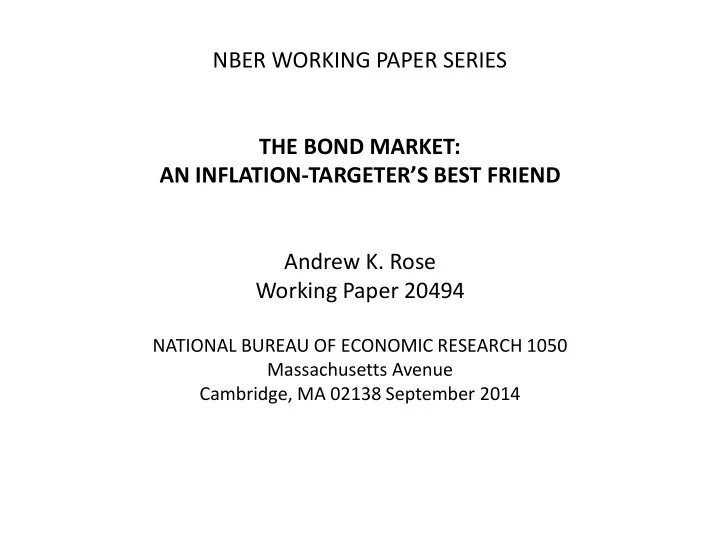

NBER WORKING PAPER SERIES THE BOND MARKET: AN INFLATION- TARGETER’S BEST FRIEND Andrew K. Rose Working Paper 20494 NATIONAL BUREAU OF ECONOMIC RESEARCH 1050 Massachusetts Avenue Cambridge, MA 02138 September 2014
Introduction • Debt is issued in many varieties: public and private, long- and short-maturity, nominal and real, and so forth. • In this paper, I ask the question: • does the very existence of such bond markets help keep inflation low and stable? • My objective is to show empirically for an important set of countries, those with inflation-targeting monetary regimes, the presence of a long, nominal, local-currency bond market is indeed associated with inflation that is approximately three-four percentage points lower.
• This finding seems intuitive: • Money creation causes an inflation tax which is paid more by the poor, If a government begins to finance its deficit by issuing bonds to the rich instead of money to the poor, it creates a powerful constituency for low inflation. • inflation is likely to be lower when the consequences of inflation tax are borne more by bond-holders and less by money-holders.
• The existence of a bond market could also have the opposite effect on inflation • Bond markets may facilitate and thus increase the size of government debt. • As long-maturity, nominal, local-currency debt increases so do the immediate government benefits (i.e., bond-holder losses) from unexpected inflation. • Thus, one might expect countries with bond markets to have higher inflation. • the linkage is theoretically ambiguous. Accordingly, I turn now to an empirical investigation.
Empirical Strategy and Methodology • My objective is to investigate whether the presence of a (long, nominal, local-currency) bond market is correlated with inflation. • my methodology is relatively low-frequency, relying on annual data for a broad panel of countries. I begin with a conventional least- squares panel estimator:
• π it is the inflation rate for country i at time t • Bond it is a binary variable (1 if country i has a bond market at time t, 0 otherwise) • {X} is a vector of controls linked to inflation: – polity (a measure of autocracy/democracy) – income (the natural logarithm of real GDP per capita) – size (log population) – openness (trade as a percentage of GDP) – demeaned real GDP growth
• The coefficient of interest to me is β, the partial-correlation between a bond market and inflation.
Simultaneity Problem • Why and when do bond markets get created? • It is natural to think that low and stable inflation is a necessary prerequisite for the existence of a long, nominal, local-currency bond market. o Perhaps then the presence of a bond market cannot be treated as exogenous for inflation; o perhaps some common cause creates the conditions for both a fall in inflation and the creation of a bond market?
• I try to handle this potential simultaneity problem in a few ways. • First, I estimate the equation only for inflation- targeting regimes (hereafter “IT”). – As a robustness check, I also consider other monetary regimes such as hard fixed exchange rate regimes. – Hard fixed exchange rate regimes may indirectly deliver low inflation or not;
• I also try two econometric strategies to deal with potential simultaneity. – I use a variety of different treatment estimators to estimate β . • I also estimate the equation with instrumental variables, relying on fiscal and political variables to construct instruments for bond market existence. – The size of government spending in the economy – The age of the country
Results
Average Treatment Effect of Long Bond Market on Inflation
Instrumental Variables Estimates
Recommend
More recommend